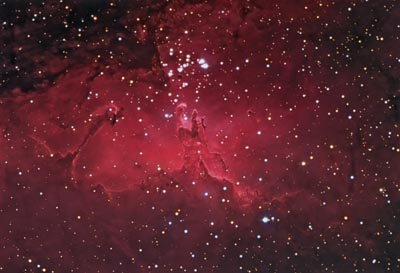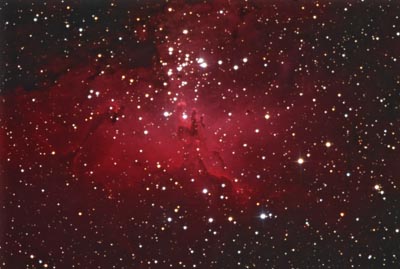M16
- The Eagle & Star Queen Nebula
Emission
Nebula in Serpens
Uploaded
8/23/09
 Below: Comparison of LRGB and G2v calibrated RGB data
Below: Comparison of LRGB and G2v calibrated RGB data
 LRGB
LRGB
|
 RGB
RGB
|
|
This object is
another example of greatly improving the compositional aspect
of a named nebula to get the best representation of the objects
namesake. A small 25 degree rotation veiled a much more dramatic
Eagle with spread wings, and the central "Star Queen"
(Named by Burnham) in an upright orientation. So many amateur
shots of this object requires you to tilt your head to view properly!
Great care was
taken on this image to maintain as closely as possible the pinks,
and magentas to reds in the original RGB image. A comparison
of the two side by side frames shows the similarity, with the
addition of L data in the left image yielding a brighter but
exactly equal shade of pink to the image on the right. You simply
cannot add brightness to an image and not keep exactly the same
shade, but the HUE is exactly the same as confirmed by the color
analysis tool in Picture Window Pro.
About this Object:
M16 is the brightest
nebula in a field of very dim nebulosity in the constellation
of Serpens just above the Galactic core. The nebula is illuminated
to shine by the bright star cluster NGC6611, which with its hot
O and B stars is at 6th magnitude. Such hot illumination yields
a much pinker color than the nearby M17, which also lies behind
a wall of thin dust, making for a more orange overall hue with
very little pink from H beta emission. The nebulosity, which
is IC4703 is a huge half a degree across and very extended beyond
this field of view, which is 3/4 a degree wide.
Inside the nebula
is a dark nebula in the shape of a person holding a book sitting
on a throne. This fanciful interpretation, originally brought
to light by Robert Burnham in his famous Celestial Handbooks
has now become even more famous by the recent Hubble space telescope
image of the queens head region. Few imaging techniques bring
this nebula to its best as well as incorporating some narrow
band hydrogen data. Here, we used a very high transmission 3
nm filter I had specially selected by Custom Scientific for maximum
transmission in Halpha.
|
Instrument: 12.5" f/5 Home made Newtonian
Mount: Astrophysics 1200 QMD
CCD Camera: SBIG 10XME NABG with Enhanced Water Cooling
Guider: SBIG ST4 w/Lumicon Newt Easy Guider
Exposure: LRGB = 180:40:40:40 L= 3nm CS Ha
AstroDon RGB Combine Ratio: 1: 1.05: 1.11 = G2V
Location: Payson, Arizona, Elevation: 5150 ft.
Sky: Seeing FWHM = 8 arcsec (Maxim DL - 10min subframe), Transparency 10/10
Outside Temperature: 65 F
CCD Temperature: -30 C
Image Processing Tools:
Maxim DL: Calibration, deblooming (Starizona Debloomer), aligning, stacking
PixInsight: Curves, Deconvolution, noise reduction
Photoshop CS2: Curves, Color Correction, Gradient removal (Grad Xterminator), Cleanup
HOME GALAXIES EMISSION NEBS REFLECTION NEBS COMETS
GLOBULARS OPEN CLUST PLANETARIES LINKS

|